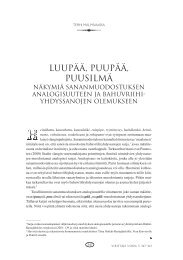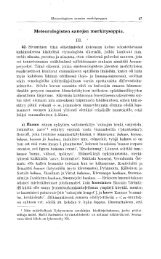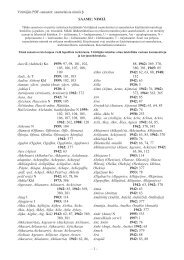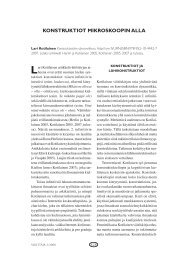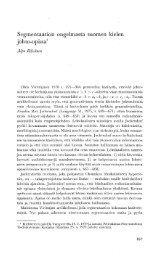pdf-tiedostona - Kotikielen Seura
pdf-tiedostona - Kotikielen Seura
pdf-tiedostona - Kotikielen Seura
Create successful ePaper yourself
Turn your PDF publications into a flip-book with our unique Google optimized e-Paper software.
TERHO ITKONEN<br />
infinitival clauses) must be bypassed here.<br />
As to the necessive infinitival clauses, it<br />
seems that the earlier pattern was the<br />
same as that of a normal ergative system:<br />
a transitive subject was expressed by a<br />
(dative) genitive, on the other hand the<br />
object, as well as an intransitive subject<br />
was originally in the nominative, later<br />
in the case of the object (= in the<br />
nominative-like accusative or partitive).<br />
Thus the pattern seemed like this:<br />
a) Pojan (gen. sg.) pitdisi syodd<br />
puuro 'the boy should eat (his)<br />
porridge' (transitive, non-existential<br />
construction, agentive subject)<br />
b) Poika (ace. sg.) pitdisi tulla kotiin<br />
'the boy should come home' (intrans.,<br />
non-existential construction,<br />
agentive subj.)<br />
c) Poika (ace. sg.) pitaisi mahtua<br />
tdlle penkille 'the boy should fit on<br />
this bench' (intrans., non-existential<br />
construction, non-agentive subj.)<br />
d) Mukana pitdisi olla poikakin (ace.<br />
sg.) 'there ought to be a boy along<br />
as well' (intrans., existential construction,<br />
non-agentive subj.)<br />
2.5.2. The history of permissive infinitival<br />
clauses is similar. A transitive<br />
subject was originally expressed by the<br />
(dative) genitive. The object, as well as<br />
an intransitive subject, was in the case<br />
of the object (the accusative, later also in<br />
the partitive). The following reconstruction<br />
may be presented:<br />
a) Annoin miesten (gen. pi.) luoda<br />
lumen T allowed the men to shovel<br />
the snow' (trans., non-existential construction,<br />
subj. agentive)<br />
b) Annoin miehet (ace. pi.) Idhted<br />
matkalle T allowed the men to go<br />
on a trip' (intrans., non-existential<br />
construction, subject agentive)<br />
c) Annoin miehet (ace. pi.) jdddd pulaan<br />
T didn't bother to help the men'<br />
(lit. T let the men remain in a<br />
pinch') (intrans., non-existential construction,<br />
subj. non-agentive)<br />
d) Annoin paikalle jdddd samat miehet<br />
'I let the same men remain in the<br />
place' (intrans., existential construction,<br />
subj. non-agentive)<br />
2.5.3. From this point onward the<br />
development in both necessive and permissive<br />
infinitival clauses was guided by<br />
two opposing levelling tendencies which,<br />
in turn, are both guided by a tendency<br />
to unify the form of an agentive subject.<br />
One of these tendencies occurred to some<br />
extent in old literary Finnish. This can be<br />
described as a trend to generalize the<br />
accusative subject into sentences of type<br />
64<br />
a according to the model provided by<br />
sentences of type b. The other tendency<br />
is typical of modern Finnish dialects and<br />
informal standard speech, and it may be<br />
observed in the literary language as well :<br />
here the genitive subject on the model of<br />
sentences of type a has been generalized<br />
into sentences of type b. Thus, in these<br />
forms of Finnish a system, similar to that<br />
of Dakota and Batsbian, depicted by<br />
Lyons as representative of the »ideal»<br />
ergative system has been realized (cf.<br />
1.5). But the development has proceded<br />
even further than this: the genitive subject<br />
has also been able to spread to<br />
sentences of type c. This is common<br />
especially in modern literary Finnish. It<br />
is of course an analogy with normal<br />
finite sentences — they too provide<br />
examples of sentences making no formal<br />
distinction between the agentive sentence<br />
type Poika (nom. sg.) tulee kotiin 'the boy<br />
is coming home', Miehet (nom. pi.) lahtevdt<br />
matkalle 'the men are going on a<br />
trip' and the non-agentive type Poika<br />
(nom. sg.) mahtuu tdlle penkille 'the boy<br />
fits on this bench', Miehet (nom. pi.)<br />
joutuivat pulaan 'the men got into a pinch'.<br />
This further development has brought<br />
with it a further degree of balance to<br />
the system. But the older system, typical<br />
of dialects and informal standard speech,<br />
makes itself known nevertheless. In these<br />
cases it has as its support both an evident<br />
tradition of the language and the human<br />
cognitive tendency to distinguish agentive<br />
action from non-agentive action. The<br />
difference between agentive and nonagentive<br />
action is polarized by nature in<br />
those cases when there is a question of<br />
an action regarded as necessary: an<br />
agentive subject can be obligued to fulfill<br />
it, but it is impossible to obligue a<br />
non-agentive subject. Equally natural is<br />
the fact that it is polarized in those cases<br />
when there is a question of an action<br />
regarded as allowable: a permission to<br />
do it can be given to an agentive subject<br />
but not to a non-agentive one. It is<br />
understandable that if this bifurcated<br />
pattern typical of the human organism<br />
has received expression in language it<br />
will not easily vanish. On the contrary,<br />
that formal bifurcation can spread by<br />
analogy to include those cases in which<br />
the ability of the subject to obey is<br />
irrelevant. This is the case in the epistemic<br />
pendants of sentences including<br />
pitdd 'shall', which also appear in two<br />
corresponding forms: 1) Pojan (gen. sg.,<br />
agentive) pitdisi jo tulla kotiin 'the boy<br />
should be coming home already' (this



